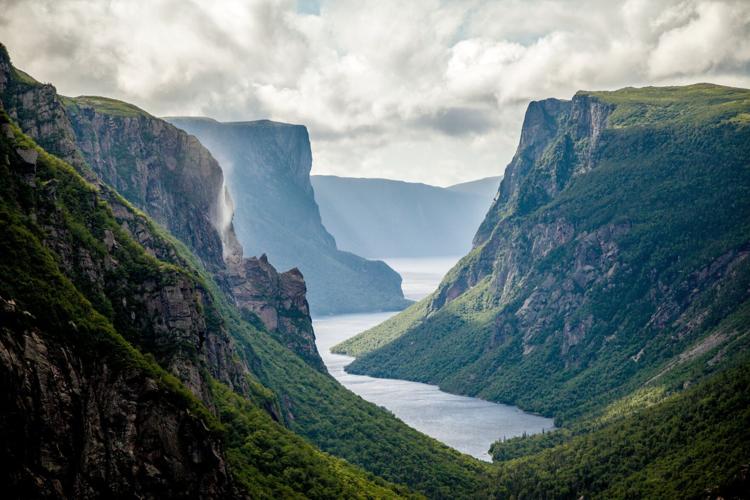It’s as iconic as the Grand Canyon or Machu Picchu or Victoria Falls, except it’s in Western Newfoundland. This place of spellbinding natural beauty is one you’ve probably seen before, on TV commercials or social media posts: a long, winding inland fiord; cliffs rising some 700 metres on each side; frothy waterfalls plunging from far above, casting a fine mist upon any little tour boats.
“At one point, these cliffs might have been as high as the Himalayas,” says guide Shelley Hann of , narrating as the views keep getting better with every turn in Gros Morne National Park. She adds that she often sees moose and caribou and bear along the banks and up on the flanks. This body of water, Western Brook Pond, was a true ocean fiord until about 8,000 years ago. “This is all freshwater,” she says, adding that it swims with salmon and arctic char, “but we still find seashells and whale bones.”

Travellers can explore Western Brook Pond on boat excursions offered by companies such as BonTours.
Newfoundland and Labrador TourismWestern Brook Pond is just one of the many wonders of . The 1,805-square-kilometre expanse is a UNESCO World Heritage site, recognized not just for its natural beauty but also its exceptional glacial features and geological marvels.
The most famous example of the latter: the Tablelands, one of the few places in the world where you can walk on the Earth’s mantle. This middle layer, below the crust, was thrust upward here during the collision of ancient continents approximately half a billion years ago.
Hiking the mantle’s rusty, Mars-like splendour is one popular option. But the landscape of the Tablelands is also beautiful when you view it from below, along the shores of Bonne Bay, on a guided boat tour. Those rocks rise dramatically from the surrounding boreal forest, their orange-red hues contrasting with the green all around.

The desert-like Tablelands is one of the few places in the world where you can walk on the Earth’s mantle.
Barrett & MacKay Photo“About 10,000 years ago, the glaciers receded, scraping those mountains and creating these valleys,” says Keith Payne, a guide with , navigating a path along the water. Bonne, he says, is actually a fiord, with all sorts of sea life, including minke whales you might spot a few metres from the shoreline path.
In addition to shoreline walks, experiences within the national park are manifold. And due to its relative remoteness, crowds tend to be mercifully minimal. You can hike along the headlands above the village of Trout River and never encounter another person. Or indulge in a lobster boil on the beach, with just your friends, and the fishing boats rolling by. There’s even some luxury to enjoy, like sitting in an outdoor cedar hot tub at the , with views of Bonne Bay and the bald dome of the park’s namesake mountain spread out before you.

For hikers, Gros Morne National Park also offers more than 100 kilometres of trails, from easy to strenuous.
Dru KennedyTaking a backcountry tour with will give you a rarely seen angle on that same summit. From the picturesque fishing town of Rocky Harbour (population: 937), co-owner Trina Reid will steer you in an off-road vehicle across the highway and onto a trail in the park. Soon, the crown of Gros Morne Mountain (height: 806 metres) will rise ahead.
The trail to the top is a popular hike, but not for the faint of heart. The 17-kilometre return trip takes the adventurous (and experienced) through challenging terrain, into an arctic-alpine environment. Those who brave it might spot rock ptarmigan or even caribou along the way. And the prize for summiting: 360-degree views that include the Ten Mile Pond gorge and the rugged Long Range Mountains.
But a tour with Reid is all about the natural beauty of the wilderness down below. She recalls that, until 1967, there was no road up the Great Northern Peninsula — which is basically all of Newfoundland north of here. “Back then, it was either the coastal boat or dog team, or you walked it.” She jokes that despite the immensity of the wilderness, you really can’t get lost: “Just put the mountain behind you, and you’ll walk to the sea.”
At the tour’s end, Reid brings travellers back to a cabin she shares with her husband and co-owner, Perry, for a steaming meal of “land and sea” (for example, moose soup and fish cakes). It pairs perfectly with the views all the way back to the rusty expanse of the Tablelands, many kilometres away.
It’s just an ideal Newfoundland combination: down-home hospitality, a super-local meal and a landscape of otherworldly wonders. And something you’ll only find in Gros Morne National Park.
Tim Johnson travelled as a guest of , which did not review or approve this article.



































To join the conversation set a first and last name in your user profile.
Sign in or register for free to join the Conversation